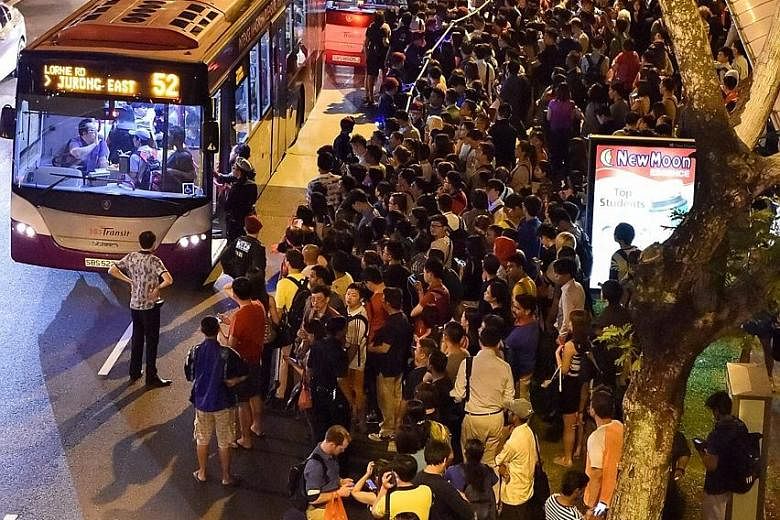What lessons can Singapore learn from the problems bedevilling its mass rapid transit (MRT)?
It was interesting that the Prime Minister raised this at the People's Action Party convention last month, considering it was a party meeting and not a government or transport conference.
But it shows how political the issue has become, and how it could, if not satisfactorily addressed, affect the party's chances at the next general election due by 2021.
To outsiders, this might be hard to comprehend. It's not as if the country is facing a corruption scandal, or large unemployment or civil unrest.
Trains breaking down?
Governments have not been known to be rattled by such mundane issues.
But Singapore's MRT problems are not straightforward either, because they are not just technical or engineering in nature but have to do with other issues such as corporate culture, the running of state-owned companies and the politics of public transport.
You could write an entire book on it with those themes and bill it as part of the Singapore Story - sterling performance in the beginning but breaking down in the later years.
So, let's begin with the first chapter on engineering competence.
Much has been said about the technical failures that have occurred over the years - ageing tracks, third rail and signalling systems that are now being replaced, and faulty water pumps.
But the biggest failure has been a loss of engineering focus at the top with not enough attention and resources deployed to ensure the system delivers what all MRTs are designed to do: safe and reliable service all the time, always keeping up with commuter demand.
Transport Minister Khaw Boon Wan put it this way in a speech last year: "We were then an exemplary MRT player and a subject of study. Unfortunately, maybe due to complacency and certainly distracted management attention, we lost our earlier mojo. At the moment I would describe the cup as three-quarters empty."
What made for the earlier mojo? There are many reasons but I believe the most important was that the men who led the company in the beginning were engineers by training and profession.
Heading it was Mr Lim Leong Geok, a Public Works Department engineer who also had a stint running Singapore Bus Services (SBS) when he led a team of government officers seconded there.
After his bus assignment, he was put in charge of the construction of the entire North-South and East-West lines, and, when it was completed, ran the train operations. In other words, a seasoned transport hand who knew the system inside out, and so did the team around him.
It was fortunate that Singapore had these pioneer transport engineers at the beginning, though it nearly lost Mr Lim.
When discussions on whether the MRT should be built became protracted in the 1980s, he told me when I was a young officer at the ministry then that if there were further delays, he would be tempted to take up a World Bank job offer in Washington.
Fortunately the Government made the decision and Mr Lim, who was also the eldest son of war hero Lim Bo Seng, became the MRT Corporation's first executive director.
Alas, those who succeeded Mr Lim were neither veterans nor had prior experience in the field. Worse, SMRT lost its transport focus and pursued other objectives such as its retail business to boost its bottom line.
How to make SMRT and SBS Transit companies of engineering excellence again?
It starts at the top, but it is also about hiring the right people, training and re-training them, making sure knowledge and information is shared and passed from one generation to another, and having top-notch quality checks and audits.
It takes time and effort to build up these processes but it isn't rocket science either.
There are many examples of companies around the world which have done this well and from which Singapore can learn: Not just MRT systems but also airports and ports, power companies, aircraft manufacturers, space agencies and military establishments.
Mr Khaw mentioned Taipei's MRT with trains able to run 800,000km before hitting a delay lasting more than 5 minutes.
Last month, I attended a talk by a representative of the French nuclear utility company EdF which operates all 58 of the country's nuclear power stations supplying 75 per cent of France's electricity needs. That's an incredibly heavy responsibility to place on one company where failure of any sort isn't an option.
It goes without saying that engineering capability and excellence is top priority, but what impressed me was the amount spent on training staff, accounting for 10 per cent of EdF's operating budget - that's at least five times if not more than that of most companies.
A large proportion of its employees stay with the company throughout their working life, ensuring deep experience at all levels.
But workers will do so only if they believe the company has their interests at heart, cares about their careers, and rewards them accordingly.
Achieving this sort of corporate culture isn't just about engineering excellence, but is, ultimately, about management and leadership.
There has been criticism about the way outsiders have been brought into SMRT, though I do not think it is necessarily a bad thing if they have the expertise and experience. But it is asking a lot of a leader if he or she is from a completely different field with no experience in mass transit.
Singapore prides itself as a country that practises meritocracy, hiring the best person for the job.
But it is equally, if not more, important, to have leaders emerge from within an organisation, acquiring experience in-house, and who have developed respect and support of peers and fellow workers.
This is far better than parachuting outsiders who will need years to get up to speed.
I hope the right lessons are learnt about where SMRT fell short in this area and what needs to be done.
Finally, there are many lessons to be learnt about how public transport is organised and operated here. It has been a journey of many twists and turns for Singapore, from the days when the Government believed public transport was best operated by private companies competing against one another without subsidies.
That thinking is now as deeply buried as an MRT tunnel.
SMRT is no longer a publicly listed company, the Land Transport Authority owns all its assets, and billions of taxpayers' dollars have been spent in recent years to improve transport services.
Despite these major moves, it is far from clear that the present structure is the best for the country in the long term.
Or if the Government should simply nationalise public transport and take charge since it is already so heavily involved.
Lessons?
You could write a book on them.
•The writer is also a senior fellow at the S. Rajaratnam School of International Studies, Nanyang Technological University.


